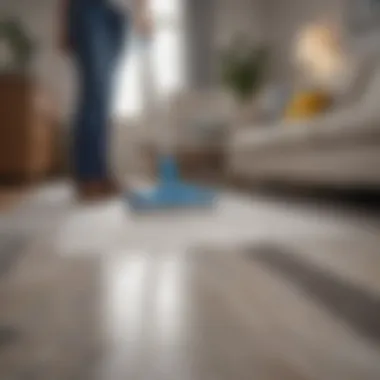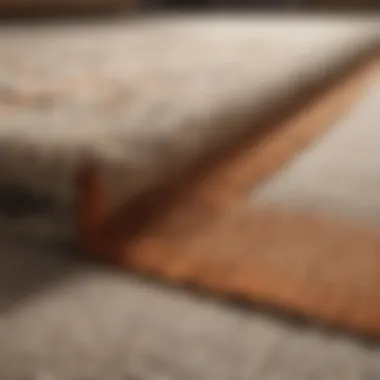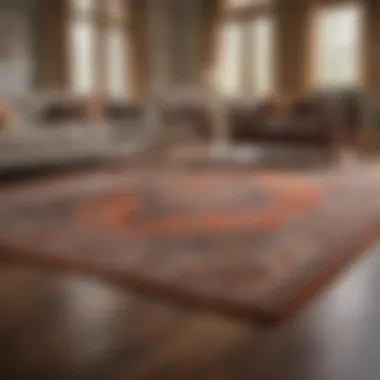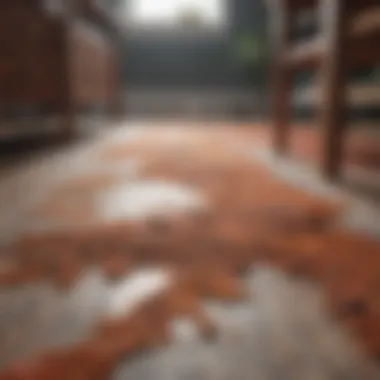A Comprehensive Guide to Disinfecting Area Rugs


Intro
Disinfecting area rugs is not merely about aesthetics; it holds significant importance for maintaining hygiene in any living space. Rugs often trap dirt, dust, and allergens, making them a potential hazard to health, especially for those with sensitivities or respiratory issues. This guide delves into the multifaceted approaches to effectively disinfect and care for area rugs, ensuring a clean ambiance at home.
Understanding your rug's material and characteristics is fundamental. Different fibers and weaves require varied methods for disinfection. Throughout the article, we will explore cleaning agents, techniques, maintenance advice, and practical tips to keep your rugs fresh. Owners and renters alike will benefit from this comprehensive examination, as knowledge in these areas ultimately promotes a healthier living environment.
Intro to Rug Disinfection
Disinfecting area rugs is a topic that bears significance in modern home hygiene practices. Rugs often act as a tapestry of family life, untold stories of moments, spills, and daily activities blend into their fibers. However, these very fibers can harbor allergens, bacteria, and unpleasant odors if not properly maintained. The act of disinfection is crucial not only for aesthetic reasons but for preserving the health and comfort of the inhabitants in the space. In essence, it can create a healthier living environment, especially for those with sensitivity to dust and other pollutants.
Importance of Disinfecting Area Rugs
The importance of disinfecting area rugs cannot be overstated. Rugs trap dust, dirt, pet dander, and other particles. These materials are potential allergens that may contribute to respiratory issues and other health problems. Furthermore, areas that witness frequent foot traffic, such as living rooms and hallways, will generally accumulate more contaminants. Disinfecting rugs helps to minimize these kinds of risks by reducing the buildup of germs and allergens.
In addition, maintaining the cleanliness of area rugs extends their lifespan. Regular disinfecting prevents wear and tear caused by grime settling into the fibers. When you clean rugs, you preserve their colors and textures, ensuring that they continue to enhance your home’s interior for years to come. It's essential for homeowners and renters to recognize that regular disinfection is a part of proper rug maintenance. This effort results in both aesthetic appeal and health benefits.
Common Sources of Contamination
Identifying the sources of contamination can help in planning a thorough disinfection strategy. Common sources include:
- Foot Traffic: Daily activities can drag in dirt and allergens from outside.
- Pets: Animals can contribute fur, dander, and occasional accidents that leave residues.
- Spills: Food and drink spills can create stains and attract insects.
- Indoor Air Quality: Dust and particles can settle onto rugs from the air.
Being aware of these sources allows individuals to better address cleaning needs, ensuring that area rugs are not only visually appealing but also a safe space for loved ones. As you consider the necessity of rug disinfection, think about how these common sources impact your living area. Taking proactive measures against contamination can maintain the overall health of your home.
Materials and Tools Needed
Disinfecting area rugs effectively requires the right materials and tools. Having these items on hand not only ensures a thorough job but also helps in prolonging the life of your rugs. Without suitable materials and tools, the disinfection process could be ineffective, potentially leading to lingering allergens and contaminants.
Cleaning Agents
Selecting appropriate cleaning agents is crucial for any disinfection process. These agents help to remove dirt, allergens, and stains while ensuring that the rug's material remains undamaged.
- pH-Neutral Cleaners: Ideal for most rugs, these are gentle yet effective. They do not cause fading or discoloration, making them safe for regular use.
- Eco-Friendly Options: For those concerned about environmental impact, there are many green cleaning agents available. These are made from natural ingredients and usually do not contain harmful chemicals, thus being safer for the household and the environment.
- Disinfectants: Look for products that specify they kill germs and bacteria. Common ingredients like hydrogen peroxide and certain alcohol-based solutions can be effective. Always follow the manufacturer's instructions for dilution and application.
When using cleaning agents, it is advisable to test a small, inconspicuous area of the rug first. This will help to avoid any adverse reactions with the material.
Essential Tools


The right tools can significantly enhance the overall effectiveness of the cleaning process. Be sure to gather the following tools before starting:
- Vacuum Cleaner: A high-quality vacuum is essential for removing loose dirt and debris from your rugs. Use one that has a beater bar or rotating brushes to ensure deep cleaning.
- Soft Brush: A soft-bristled brush can be valuable for gently scrubbing the rug without damaging its fibers.
- Spray Bottles: These are useful for applying cleaning agents evenly across the surface of the rug.
- Wet-Dry Vacuum: This tool can help in rinsing and removing excess moisture after cleaning, which is vital to prevent mold growth.
- Towels: Absorbent towels are needed for drying the rugs after thorough cleaning. Avoid leaving moisture trapped in the fibers.
It is critical to have these tools on hand as they can simplify the process and improve the results. Using the correct materials and tools will ensure that the disinfecting process is both effective and efficient.
Step-by-Step Disinfection Process
Disinfecting area rugs is not simply a chore; it is a vital procedure that ensures your living environment remains healthy and appealing. Each step in the disinfection process contributes to the overall cleanliness and longevity of your rugs. It aids in combatting allergens and odors that can accumulate over time, ultimately creating a fresh atmosphere in your home. In this section, we will elaborate on the essential steps for successful rug disinfection.
Initial Preparation of the Rug
Before diving into cleaning, you need to take time for initial preparation. This is an essential phase that lays the groundwork for effective disinfection. Begin by removing any loose dirt and debris from the rug. A vacuum cleaner can be your best friend here. Make sure to use a vacuum designed for the type of rug you have. Pay particular attention to edges and corners, where dirt often hides.
Once you have vacuumed, inspect the rug for stains or areas of concern. Identifying these spots early allows for targeted treatment later. If your rug is delicate, consider shaking it outside to dispel dust rather than beating it, to avoid damage. Preparing the rug properly will enhance the effectiveness of subsequent cleaning steps.
Applying Cleaning Solutions
Choosing the right cleaning solution is crucial for ensuring proper disinfecting of your rug. Different materials require different solutions. When you apply the cleaning agent, follow these steps:
- Select a Cleaning Agent: For synthetic rugs, a mild detergent mixed with warm water usually suffices. For wool or natural fibers, you might want to consider special agents that are specifically designed for those fabrics.
- Spot Test the Cleaner: Always conduct a patch test on a small, hidden area of the rug to ensure the solution does not cause discoloration or damage.
- Application: Using a spray bottle or sponge, gently apply the cleaning solution to the rug. It’s important to avoid soaking the rug, as too much moisture can lead to mold growth.
- Agitation: Use a soft brush to delicately agitate the fibers. This will help the cleaning agent penetrate deeper into the rug.
Applying the right cleaning solution successfully breaks down dirt and allergens, preparing the rug for rinsing.
Rinsing and Drying Techniques
After the cleaning solution has done its job, rinsing is the next essential step. This part helps rid the rug of any remaining cleaning agents, ensuring no residue is left behind. Here’s how to effectively rinse and dry your rug:
- Rinse: Use a clean sponge or cloth soaked in plain water to remove the cleaning solution. Wipe the rug sections thoroughly until suds disappear. This may take some time, but it is necessary for a complete cleaning.
- Drying: Avoid wringing out the rug; this can distort its shape. Instead, lay it flat in a well-ventilated area. If possible, hang it to encourage airflow. Direct sunlight can help speed up the drying process but may not be suitable for all rugs due to potential fading.
Proper drying is critical. Any leftover moisture can lead to mold or mildew, compromising the rug's integrity and your home's air quality.
By following these steps, homeowners can ensure that their area rugs remain clean and in good condition over time. Integrating these practices into your cleaning routine can make a significant difference in maintaining a fresh living environment.
Types of Area Rugs and Their Unique Requirements
Understanding the various types of area rugs is crucial for effective disinfecting procedures. Each type of rug comes with its own set of characteristics, making it essential to tailor your cleaning methods accordingly. Different materials have unique cleaning requirements and considering these can prolong the lifespan of your rugs while maintaining their aesthetic appeal. This section delves into the specifics of natural fiber rugs, synthetic rugs, and wool rugs, highlighting how their composition affects the disinfection process.
Natural Fiber Rugs


Natural fiber rugs are made from materials such as jute, sisal, and cotton. These fibers are biodegradable and often preferred for their eco-friendliness. However, their porous nature makes them susceptible to absorbing dirt, spills, and allergens.
When disinfecting these rugs, it's important to avoid excessive moisture to prevent mold growth. Here are some essential tips:
- Use a gentle cleaning solution specifically designed for natural fibers.
- Test the cleaning agent on a small, inconspicuous area first.
- Regular vacuuming is necessary to maintain cleanliness and reduce allergens.
Being aware of how dirt and allergens can accumulate in natural fiber rugs will help homeowners select the right methods for upkeep.
Synthetic Rugs
Synthetic rugs, often crafted from nylon, polyester, or polypropylene, offer durability and ease of cleaning. Their resistance to stains and fading is a significant advantage.
For disinfecting synthetic rugs, remember to:
- Use water-based cleaning solutions that won't damage the rug fibers.
- Employ a steam cleaner if permitted by the manufacturer, as heat can help kill bacteria and allergens.
- Blot spills immediately to prevent stains from setting in.
Being aware of the cleaning requirements of synthetic rugs helps homeowners employ effective routines.
Wool Rugs
Wool rugs are prized for their warmth, softness, and durability. Though they are naturally stain-resistant, they still require special attention.
When disinfecting wool rugs, keep in mind:
- Avoid harsh chemicals that can damage the fibers.
- Use a solution that includes mild detergents and ample water.
- Eco-friendly options are preferable for maintaining wool fibers.
Recognizing wool’s unique characteristics can assist in developing effective cleaning strategies to ensure longevity.
Preventive Measures for Rug Maintenance
Maintaining the cleanliness and longevity of area rugs is not purely a matter of intensive cleaning practices. It involves implementing preventive measures that can significantly reduce the need for frequent disinfection. Proper rug maintenance ensures that rugs not only look good but also contribute to a healthy living environment. Dust, allergens, and dirt can accumulate if rugs are not taken care of regularly, leading to the need for deep cleaning methods that can wear down the fibers over time. Through consistent maintenance routines, homeowners can protect their investments and maximize the value of their rugs.
Routine Cleaning Practices
Routine cleaning is a foundational aspect of preventive maintenance for area rugs. Regular vacuuming can help eliminate dirt and dust that might accumulate. An effective approach includes:
- Weekly vacuuming: Ideally, vacuums with a beater bar should be used, but an option that is gentle on fibers may be preferable for delicate rugs.
- Spot cleaning: Immediate attention to spills can prevent stains from setting in, turning what could be a major issue into a minor inconvenience.
- Rotation: Periodically rotating rugs helps to ensure even wear, especially in high-traffic areas. This also exposes various parts of the rug to sunlight, reducing the risk of fading.
- Professional cleanings: Scheduling a professional cleaning every few years is advisable, depending on usage. This can help maintain the rug’s health over a longer duration.
In summary, adhering to these practices fosters an environment where rugs can thrive without the constant need for intensive cleaning.


Environmental Considerations
Environmental aspects of rug maintenance should not be overlooked. The materials used in both rugs and cleaning agents can have an impact on health and sustainability. Several factors to consider include:
- Eco-friendly cleaners: Choosing non-toxic and biodegradable cleaning products contributes to a safer environment. Synthetic chemicals can leave harmful residues that trap allergens.
- Humidity levels: Rugs should be kept in areas where humidity is managed. Excess moisture can lead to mold growth, which not only damages the rug but also impacts air quality in the home.
- Air circulation: Ensuring that spaces with rugs are well-ventilated will help in avoiding moisture accumulation and odors.
- Natural materials: Selecting rugs made from natural fibers can promote a healthier living space as they typically have fewer chemicals involved in their production compared to synthetic options.
Investing in preventive measures for rug maintenance is both a cost-effective and health-conscious decision. It cultivates a cleaner home, prolongs the life of rugs, and resonates with eco-friendly practices.
By integrating thoughtful cleaning routines and environmental considerations, homeowners can maintain the integrity of their rugs. This not only enhances the aesthetic value of their spaces but also fosters a healthy living environment.
Troubleshooting Common Problems
When it comes to area rugs, various issues may arise that hinder their appearance and effectiveness in maintaining a clean environment. Understanding how to troubleshoot these common problems is vital. By addressing problems like stubborn stains and lingering odors, homeowners can prolong the life of their rugs while ensuring a healthy home atmosphere. By following systematic approaches to these issues, individuals can maintain a fresh and attractive space that is devoid of unpleasant surprises.
Tackling Stubborn Stains
Stains on rugs can result from a range of causes, such as spills, pets, or even foot traffic. Identifying the type of stain is the first step in addressing the problem. For instance, a food stain may require different treatment compared to an ink or pet urine stain. Here are several approaches to effectively tackle stubborn stains:
- Immediate Action: Addressing a stain right after it occurs is crucial. Use a paper towel or clean cloth to blot the area, absorbing as much liquid as possible without rubbing, which can set the stain.
- Choosing the Right Cleaner: Select a suitable cleaning agent based on the type of stain. For example, a mix of vinegar and water can assist with food stains, while a specialized carpet cleaner may be needed for tougher issues.
- Gentle Scrubbing: After applying the cleaner, gently scrub the area with a soft brush or cloth. This will help lift the stain without damaging the fibers of the rug.
- Rinsing: It is important to remove any remaining cleaner from the rug, as residue can attract dirt and lead to further staining. Blot the area with a damp cloth as part of the rinsing process.
- Assistance for Persistent Stains: For stains that resist conventional cleaning methods, consider contacting a professional cleaning service. They often have access to advanced techniques and solutions that can effectively remove tough stains.
Addressing Odors in Rugs
Odors trapped in rugs can be bothersome, often stemming from spills, pets, or moisture. Identifying the source of the odor is essential for effectively eliminating it. Here are some strategies to combat unpleasant smells:
- Baking Soda Treatment: One of the simplest solutions is to sprinkle baking soda generously over the affected areas. Leave it for a few hours or overnight to absorb odors, then vacuum it up. This method is especially useful for pet odors.
- Vinegar Solution: Mixing equal parts water and white vinegar and lightly spraying it on the rug can help neutralize bad smells. Ensure not to soak the rug; a light mist is sufficient. Follow up by allowing it to air dry.
- Regular Airing Out: Sometimes, just taking the rug outdoors in fresh air can do wonders. The movement of air can help in removing stagnant odors that are trapped in the fibers.
- Professional Cleaning: If odors persist despite home treatments, it may be time to consider professional cleaning services. They can remove deeply embedded dirt and odor sources, restoring your rug to its former state.
By effectively tackling stains and odors, homeowners can enhance their rugs' overall appearance and lifespan. Addressing these issues promptly not only keeps the rugs looking inviting but also contributes to a healthier home environment. The effort invested in maintaining area rugs will ultimately result in a greater quality of life in your living spaces.
Culmination
Understanding the importance of disinfecting area rugs is crucial for maintaining a healthy and inviting home environment. This article has highlighted several strategic elements that contribute to effective rug disinfection, enabling you to combat allergens and promote cleanliness within your living spaces.
Summary of Key Points
In summary, this guide has explored the following key aspects of rug disinfection:
- Importance of Disinfecting: Regular disinfecting is vital to remove allergens and maintain the fabric integrity.
- Materials and Tools: Appropriate cleaning agents and tools play a critical role in achieving effective results.
- Detailed Procedures: Following a structured process — from preparation to rinsing — ensures thorough disinfection.
- Types of Rugs: Each rug type has unique hygiene requirements that need specific attention.
- Preventive Measures: Establishing routine cleaning practices will prolong the life of your rugs.
- Troubleshooting: Knowing how to tackle stains and odors is essential for ongoing maintenance.
Together, these elements provide a solid foundation for anyone looking to ensure that area rugs contribute positively to their home environment.
Encouragement for Regular Maintenance
To maintain a clean and pleasant atmosphere, it is not enough to disinfect rugs just once or twice a year. Making rug disinfection a regular part of your cleaning routine helps to significantly reduce allergens, dust, and potentially harmful microbes that accumulate over time. Regular maintenance simply enhances the longevity of your rugs while also preserving their aesthetic appeal.
For inspiration, consider setting monthly reminders to perform basic cleaning tasks, including vacuuming and spot treatments. This will promote a healthier living space and keep your area rugs looking fresh longer.



